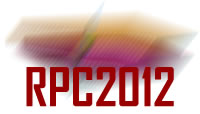Speaker
Ms
Chia-Yu Hsieh
(Institute of Physics,Acdemia Sinica, Taipei, 115, Taiwan)
Description
The LEPS2/SPring-8 experiment of photo-production of vector mesons and hyperons is scheduled to start in 2013. The photon beam with energy up to 3 GeV is produced by backward Compton scattering of laser photon with 8 GeV electrons inside SPring-8 storage ring. The development of a 4pi detectors and the construction of a solenoid magnet is currently underway.
Pions and kanos with their momenta up to 2.5 GeV/c are produced from the high-energy photon with nucleon target. In order to separate 1.1 GeV/c of K/pi with time of flight (TOF) while traveling in a distance of 100cm in the magnet, we need a large-area, high-efficiency TOF detector with a time resolution of 50-100 ps. The multigap resistive plate chamber (MRPC) is chosen in LEPS2.
We made a 150um*12 gaps MRPC with an active area of 10*50 cm^2.The pad size was 1.5*5.5 cm^2.We studied the trigger rate dependence and gas mixture for the optimized design of MRPC.
The positron from the pair production of high-energy photon via convertor is used for the beam test. The trigger rate of positron beam was mainly determined by the intensity of injected laser. We found that high enough voltage is necessary to achieve a good time resolution and high efficiency at a large trigger rate. When the trigger rate is as high as 20 Hz/cm^2, it has a good time resolution (50ps) and high efficiency (~99%) at 12 kV. We also investigated the effect of gas mixture. We chose Butane as the quencher, because Butane is cheaper than Iso-butane and both of them play a similar role as the quencher. A gas mixture of R134a:SF6:Iso-butane is 90%:5%:5% is our optimized choice with 50-ps time resolution and 99% efficiency.
In the future we will study further the effect of the impedance of pad and develop the amplifier for the readout of MRPC. In the final, a total area of 10*100 cm^2 MRPC will be produced for the LEPS2 experiment.
Summary
In order to separate 1.1 GeV/c of K/pi with the TOF in traveling through 100cm in the magnet, we will use MRPC under the consideration of needs of large area, high efficiency and overall time resolution in the range of 50-100ps. We made a 150um12 gaps MRPC with an active area of 1050 cm^2, and the pad size was 1.5*5.5 cm^2.We studied trigger rate dependence and gas mixture for the optimized design of MRPC. We found that high enough voltage is necessary to achieve a good time resolution and high efficiency at a large trigger rate. Because Butane is cheaper than Iso-butane and both of them play a similar role as the quencher, a gas mixture of R134a:SF6:Iso-butane is 90%:5%:5% is our optimized choice.
Authors
Ms
Chia-Yu Hsieh
(Institute of Physics,Acdemia Sinica, Taipei, 115, Taiwan)
Ms
Natsuki Tomida
(Division of Physics and Astronomy, Kyoto University, Kyoto, 8502, Japan)
Co-authors
Prof.
Hiroaki Ohnishi
(RIKEN, 2-1 Hirosawa, 351-0198 Wako-shi, Saitama, Japan)
Prof.
Masayuki Niiyama
(Division of Physics and Astronomy, Kyoto University, Kyoto, 8502, Japan)
Prof.
Wen-Chen Chang
(Institute of Physics,Acdemia Sinica, Taipei, 115, Taiwan)
Prof.
Willis Tsung-Tai Lin
(Department of Physics, National Central University, Jung-Li, 32001,Taiwan)

